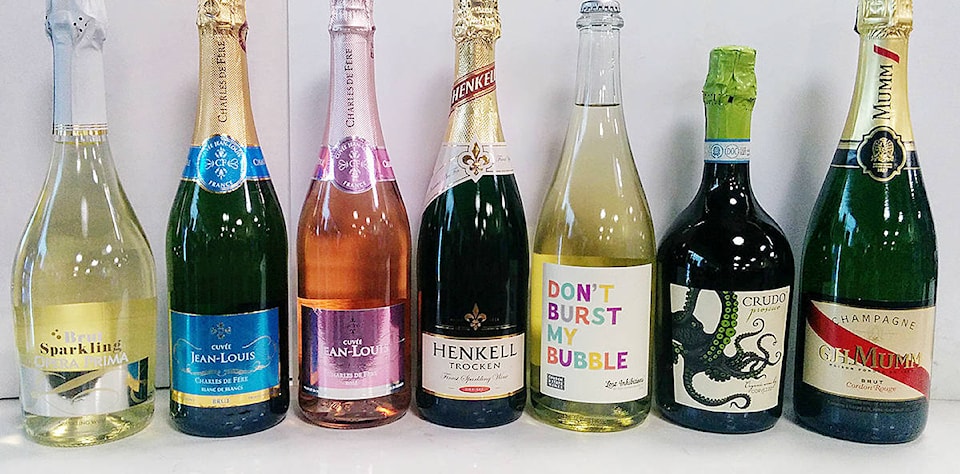Maybe because of the traditional hype around popping corks on New Year’s Eve even the most recently converted wine lovers will probably find a bottle of sparkling wine to open on Dec. 31.
There’s much more to bubblies, these days, than the classic Champagnes from France.
Spain is the world leader when it comes to land planted to wine grapes with more hectares of vineyard than any other country. In the north, south, east and west huge vineyards are dedicated to wine, serving to create an enormous range of styles.
Astonishing sparkling wine like Opera Prima Brut (862144) $9.99 is without a doubt the most affordable, elegant sparkling wine from Spain.
Made in the less labour intensive ‘Charmat’ style, bright pale yellow in the glass, it offers an intense aroma of fresh citrus fruits, an expression of herbs and hints of flower petals.
Not to be outdone, France also produces numerous and much more affordable alternatives to their famous Champagnes.
A blend of various white grapes – but primarily Chenin Blanc and Ugni Blanc - Cuvee Jean Louis Sparkling White (156711) $9.99 is bright and fruity, brimming with flavours of apples and honeyed apricots. At this price, this is a steal!
Gamay Noir, Grenache, Pinot Noir, Airen and Ugni Blanc all go in to Cuvee Jean-Louis Sparkling Rosé (483396) $9.99. Fresh and fruity with aromas of ripe red berries, this is perfect paired with soft white cheese appetizers or slivered ham.
Unwilling to be left out, Germany produces their own sparkling wines. With Germanic origins, the hugely popular, Henkell Trocken (122689) $12.49 is dependable, consistent and made today from classic grape varieties sourced from France - Chardonnay and Sauvignon Blanc, as well as Pinot Noir and Chenin Blanc.
The bubbles in all sparkling wines are one of the not so well-known reasons they are widely used as ‘social lubricants’.
A smattering of the alcohol in the wine is carried up into your sinus cavities by the tiny bursting bubbles. Being well supplied with rich bilateral blood circulation, your sinus cavities help the alcohol seep very speedily and directly into your arterial bloodstream and on to your brain.
With the cheekiest labels on the shelves, Lost Inhibitions wines, by British Columbia’s own Church & State are infinitely entertaining and brimming with personality. The seemingly infinite range of rainbow texted labels have sage words for every occasion.
Lost Inhibitions Sparkling White (29127) $17.99 is a blend of 85 per cent Chardonnay and 15 per cent Muscat. Not quite completely dry and at least as sassy as its labels, it features bright, fresh flavours of apples and pears with undertones of peaches, mangos and pineapples.
Don’t look at Prosecco as being Italy’s version of a poor man’s Champagne. Produced by the much less labour intensive ‘Charmat’ method - Prosecco is held in large stainless-steel containers for 8-12 weeks before being bottled under pressure, helping it retain all the fresh, bright, fruity flavours.
New to British Columbia, Crudo Organic Prosecco (139199) $21.99 has an eye-catching label that features an octopus and comes in an unusually squat bottle. Made from Glera grapes in the Veneto region of northern Italy, it offers a medley of classic stone fruit aromas and flavours over a base of brisk lemon and grapefruit with a twist of chalky minerality in the finish.
And then, of course there are the classic sparkling wines from northern France’s Champagne regions. Finding a bottle of authentic Champagne under $50, however, can sometimes be a problem.
The dominant chalky sub-soil of the Champagne region in France is punctuated by limestone in the southernmost zones and areas of heavier clay elsewhere, giving a real range of mineral possibilities throughout Champagne’s various sites.
One of the most recognizable bubblies in the world with a slash of red ribbon across its cream coloured label, Mumm Cordon Rouge Brut Champagne (308056) $49.99 is a textbook blend of 45 per cent Pinot Noir, 30 per cent Chardonnay and 25 per cent Pinot Meunier.
Fresh apple, peach and apricot notes slide into creamy notes of tropical mango and pineapple. Dusty hints of toasty vanilla emerge in the aftertaste.
Reach WineWise by emailing douglas_sloan@yahoo.com
